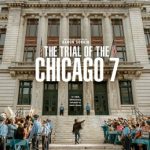‘There’s more future in the past than there is in the future’
“There’s more future in the past than there is in the future,” Jackie Kay’s lead character says in her extraordinary and lyrical novel ‘Trumpet’. Ms Kay, the Scottish poet laureate or Makar, was quoting something she had heard Toni Morrison say. She uses the line in ‘Trumpet’; the speaker is Joss Moody, a celebrated Black Scottish jazz musician, who is revealed upon his death to have been anatomically female. For Moody, there was a lot of future in the past.
I remembered that line while watching ‘The Trial of the Chicago 7’.
It’s a Netflix thriller about the 1968 anti-war protests, when the police behaved violently and unjustifiably and the full force of president Richard Nixon’s administration was brought to bear upon what the film calls the “radical left”. There’s more future in the past than there is in the future.
The Aaron Sorkin film, fast-moving, beautifully written and with an impressive cast that includes Sasha Baron Cohen and Mark Rylance, shows the police and elements of the state as malevolent and loathsome, but this is not about artistic license. As a film reviewer recently pointed out, “The Walker Report, the official enquiry into the riots, was based on 20,000 pages of testimony from more than 3,000 witnesses, and was unequivocal in its conclusion: ‘Individual policemen, and lots of them, committed violent acts far in excess of the requisite force for crowd dispersal or arrest. To read dispassionately the hundreds of statements describing at first-hand the events of Sunday and Monday nights is to become convinced of the presence of what can only be called a police riot’.” There’s more future in the past than there is in the future.
In the film, Black Panthers co-founder Bobby Seale is constantly put down by Judge Hoffman, in what is obviously a racist response. Seale, whose lawyer, the famous Charles Garry, was taken ill on the eve of the trial, repeatedly asks to cross-examine witnesses himself but is prevented from doing so by the judge. At one point the film’s Seale tells the judge: “This racist administration government with its Superman notions and comic book politics. We’re hip to the fact that Superman saved no black people. You got that?… You have did everything you could with those jive lying witnesses up there presented by these pig agents of the government to lie and say and condone some rotten racists, fascist crap by racist cops and pigs that beat people’s heads in and I demand my constitutional rights!” He ends up being gagged and chained to a chair – a denial of rights and due process and unthinkable in an American courtroom. There’s more future in the past than there is in the future.
The ending was thrilling and theatrical. In the film, at the sentencing, the political activist Tom Hayden reads out the names of every American who’d died in Vietnam since the start of the trial.
In reality, the actual trial ended with the white defendants denouncing systemic racism. For instance, Dave Dellinger, one of the defendants said: “Whatever happens to us, however unjustified, will be slight compared to what has happened already to the Vietnamese people, to the Black people in this country, to the criminals with whom we are now spending our days in the Cook County jail.” There’s more future in the past than there is in the future.
The film ends as Hollywood films do…on a high. It reawakens hope that hate and lies can be overcome and that acts of individual courage matter. There’s more future in the past than there is in the future.
Watching the film in this moment, with Donald Trump in the White House and the Black Lives Matter protests fresh in the memory, it’s doubly clear: There really is more future in the past than there is in the future.



